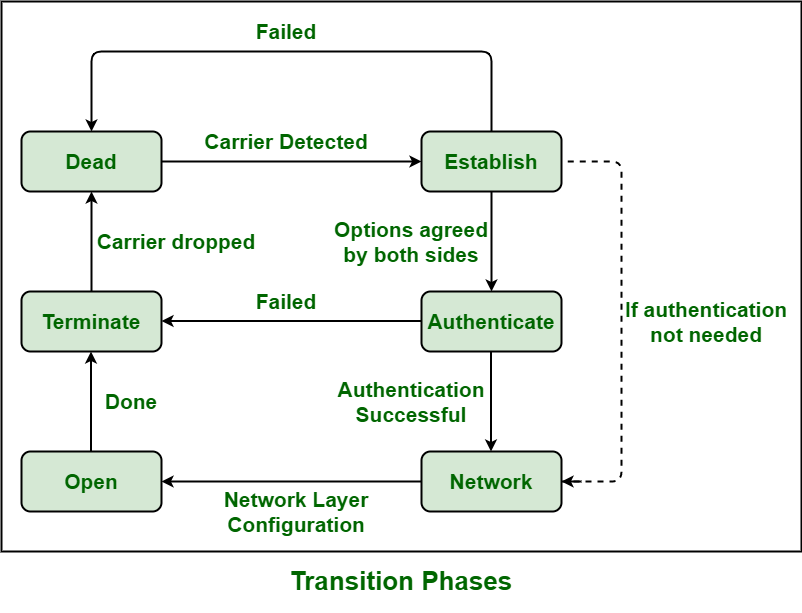Point-to-Point Protocol (PPP) Phase Diagram
Last Updated :
12 Aug, 2020
Point-to-Point Protocol (PPP) was generally invented by Internet Engineering Task Force (IETF) simply to create and develop a data link protocol for point to point lines that can be helpful in solving many of the problems that are present in SLIP.
PPP can operate on different DTE/DCE (Data Terminal Equipment/Data Circuit-Terminating Equipment) physical interfaces along with asynchronous serial, synchronous serial, ISDN, etc. It can also operate on various network layer protocols such as IPX, AppleTalk, whereas on the other hand, SLIP only operates on TCP/IP-based protocols. All of the point-to-point links that utilize PPP protocol needs to be able to support full-duplex communication.
PPP Phase Diagram :
PPP connection generally goes through different phases that can be seen in Transition Phase Diagram as shown below :

- Dead –
In this phase, link basically starts and stops. Carrier Detection is an event that is used to indicate that physical layer is ready, and now the PPP will proceed towards establishment phase. Disconnection from modem line must bring back the line or connection to this phase. LCP automation is usually in the initial or starting phase during this phase.
- Establish –
Link then proceeds towards this phase after the presence of peer is being detected. When one of nodes starts communication, then connection goes into this phase. By the exchange of LCP Frames or packets, all of configuration parameters are negotiated. If somehow negotiation meets at a point, link is developed and then system goes either into authentication protocol or network layer protocol. The end of this phase simply indicates open state of LCP.
- Authenticate –
In PPP, authentication is optional. Peer authentication can be requested by one or both of the endpoints. PPP enters authentication phase if Password Authentication Protocol (PAP) or Challenge-Handshake Authentication Protocol (CHAP) is configured.
- Network –
PPP basically sends or transmits NCP packets to choose and configure one or more network-layer protocols such as IP, IPX, etc. once LCP state is being open and link or connection is established. This is especially required to configure the appropriate network layer.
In this phase, Each of Network control protocols might be opened and closed at any time and negotiation for these protocols also takes place. At network layer, PPP also supports various protocols due to which PPP specifies that two of nodes establish or develop a network layer agreement before data is exchanged at network layer.
- Open –
Usually transferring of data takes place in this phase. Once endpoints want to end the connection, connection is then transferred to terminate phase, till then connection remains in this phase.
- Terminate –
Connection can be terminated at any point of time as per the request of either of the endpoints. LCP is basically required to close or terminate link through the exchange of terminate packets.
Share your thoughts in the comments
Please Login to comment...